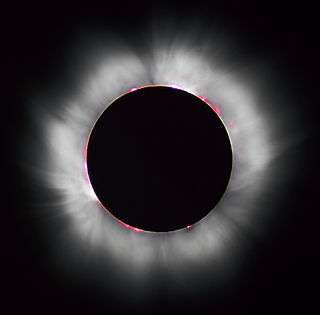Coronium

Coronium, also called newtonium, was the name of a suggested chemical element, hypothesised in the 19th century. It was named after the solar corona. This new atomic thin green line in the solar corona was then considered to be provenient from a new element unlike anything else seen under laboratory conditions. Because of this it was also mis-classified as Iron Line Number 1474.[1]
Solar spectroscopy
During the total solar eclipse of 7 August 1869, a green emission line of wavelength 530.3 nm was independently observed by Charles Augustus Young (1834–1908) and William Harkness (1837–1903) in the coronal spectrum. Since this line did not correspond to that of any known material, it was proposed that it was due to an unknown element, provisionally named coronium.
In 1902, in an attempt at a chemical conception of the aether, the Russian chemist and chemical educator Dmitri Mendeleev hypothesized that there existed two inert chemical elements of lesser atomic weight than hydrogen. Of these two, he thought the lighter to be an all-penetrating, all-pervasive gas, and the slightly heavier one to be coronium. Later he renamed coronium as newtonium.[2]
It was not until the 1930s that Walter Grotrian and Bengt Edlén discovered that the spectral line at 530.3 nm was due to highly ionized iron (Fe13+); other unusual lines in the coronal spectrum were also caused by highly charged ions, such as nickel, the high ionization being due to the extreme temperature of the solar corona.[3]
See also
Additional information
References
- ↑ Cosmos Portal. "Solar Spectroscopy: Coronium". Cosmos Portal. Retrieved 3 December 2011.
- ↑ Ede, Andrew (2006). The Chemical Element: A Historical Perspective. Greenwood Press. pp. 83–84. ISBN 0-313-33304-1.
- ↑ Morison, Ian (2008). Introduction to Astronomy and Cosmology. Wiley-Blackwell. p. 61. ISBN 0-470-03333-9.
Further reading
- Claridge, George C. (1937). "Coronium". Journal of the Royal Astronomical Society of Canada. 31: 337–346. Bibcode:1937JRASC..31..337C.
External links
- Laser Stars. "History of Coronium". Retrieved 2008-08-25.